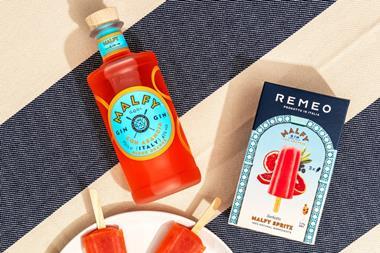Sales of frozen food have rocketed in the past year. But is its popularity sustainable, or will it end at the same time as the recession, asks Alex Beckett
Last month marked a landmark moment for frozen food. For the first time, total category sales broke the £5bn barrier, leapt 6.3% to £5.1bn in the year to 14 June 2009 [TNS] following modest yet significant growth of 1.4% the previous year.
Cash-strapped consumers have been heading to the freezer aisle in record numbers, enticed by value-driven offerings from the likes of Birds Eye, McCain and a revitalised own-label sector. But when the green shoots of economic recovery arrive, as they inevitably will, is frozen in a position to maintain its new-found momentum?
The credit crunch is one factor supporting the growth of the frozen food market, says Brian Young, director of the British Frozen Food Federation. "Consumers have lost their faith in banks, mortgages and house prices, so an awful lot of ways of thinking have been challenged during the recession - including thoughts on sustainability and food wastage," he says. "And the frozen food industry is getting better at communicating the ways it is tackling these issues."
However, he adds, the category had already been laying the foundations for growth before the downturn. Two organisations in particular have injected a new sense of purpose and clarity to the category, he believes.
"Before the recession, the structural organisation of frozen was getting better, but Birds Eye in particular has got its act together. Unilever sold the business in 2006 and the people in charge now have a longer-term perspective," he says. "Iceland's also regained its focus since Malcolm Walker returned to the helm. Such structural improvements are integral to the category's current and future success."
Pete Johnson, trade marketing manager at Birds Eye, agrees the frozen industry has made its own luck and is equally confident that the sales momentum will be maintained when consumer spending picks up.
"The foundations of the category growth began with refreshed packaging, strong promotions and great-tasting innovation from companies like Birds Eye," he says. "Shoppers either rediscovered the benefits of the sector or realised them for the first time. The economic slowdown then caused households to reassess food wastage and food budgets, which accelerated this growth."
Where frozen faces a challenge, says Johnson, is in persuading retailers that consumers are ready to pay full price for frozen foods in line with what they pay for fresh goods. The category is still awash with promotional deals, which, while they may drive consumers to freezer aisles in the short term, are unlikely to result in sustainable value growth. "T he trick to future growth is making unpromoted lines attractive on-shelf too," he explains. One category where consumers are learning to pay full price is frozen ready meals, where sales fell 4.4% in volume but increased 2.8% in value, for instance.
Young views this statistic as positive. "If this is a sign we are putting quality back into ready meals at the expense of volumes, then I'm delighted."
Improved retailer management of the frozen category since the downturn has also improved sales, says Paul Sternlieb, marketing director of frozen foods at Heinz, but even closer collaboration between retailer and supplier is necessary to ensure continued category growth. "For retailers, it's about improving the shopping experience, which can often be quite cold and uninviting. Availability also continues to be a significant issue in frozen. But it can be solved through more collaborative forecasting and improvements in store operations."
With strong sales figures, record marketing campaign spends and busy NPD schedules, no-one can accuse Birds Eye, McCain or Aunt Bessie's of resting on their laurels during the downturn.
And they won't when it's over if they want to ensure frozen's prospects remain hot.
Last month marked a landmark moment for frozen food. For the first time, total category sales broke the £5bn barrier, leapt 6.3% to £5.1bn in the year to 14 June 2009 [TNS] following modest yet significant growth of 1.4% the previous year.
Cash-strapped consumers have been heading to the freezer aisle in record numbers, enticed by value-driven offerings from the likes of Birds Eye, McCain and a revitalised own-label sector. But when the green shoots of economic recovery arrive, as they inevitably will, is frozen in a position to maintain its new-found momentum?
The credit crunch is one factor supporting the growth of the frozen food market, says Brian Young, director of the British Frozen Food Federation. "Consumers have lost their faith in banks, mortgages and house prices, so an awful lot of ways of thinking have been challenged during the recession - including thoughts on sustainability and food wastage," he says. "And the frozen food industry is getting better at communicating the ways it is tackling these issues."
However, he adds, the category had already been laying the foundations for growth before the downturn. Two organisations in particular have injected a new sense of purpose and clarity to the category, he believes.
"Before the recession, the structural organisation of frozen was getting better, but Birds Eye in particular has got its act together. Unilever sold the business in 2006 and the people in charge now have a longer-term perspective," he says. "Iceland's also regained its focus since Malcolm Walker returned to the helm. Such structural improvements are integral to the category's current and future success."
Pete Johnson, trade marketing manager at Birds Eye, agrees the frozen industry has made its own luck and is equally confident that the sales momentum will be maintained when consumer spending picks up.
"The foundations of the category growth began with refreshed packaging, strong promotions and great-tasting innovation from companies like Birds Eye," he says. "Shoppers either rediscovered the benefits of the sector or realised them for the first time. The economic slowdown then caused households to reassess food wastage and food budgets, which accelerated this growth."
Where frozen faces a challenge, says Johnson, is in persuading retailers that consumers are ready to pay full price for frozen foods in line with what they pay for fresh goods. The category is still awash with promotional deals, which, while they may drive consumers to freezer aisles in the short term, are unlikely to result in sustainable value growth. "T he trick to future growth is making unpromoted lines attractive on-shelf too," he explains. One category where consumers are learning to pay full price is frozen ready meals, where sales fell 4.4% in volume but increased 2.8% in value, for instance.
Young views this statistic as positive. "If this is a sign we are putting quality back into ready meals at the expense of volumes, then I'm delighted."
Improved retailer management of the frozen category since the downturn has also improved sales, says Paul Sternlieb, marketing director of frozen foods at Heinz, but even closer collaboration between retailer and supplier is necessary to ensure continued category growth. "For retailers, it's about improving the shopping experience, which can often be quite cold and uninviting. Availability also continues to be a significant issue in frozen. But it can be solved through more collaborative forecasting and improvements in store operations."
With strong sales figures, record marketing campaign spends and busy NPD schedules, no-one can accuse Birds Eye, McCain or Aunt Bessie's of resting on their laurels during the downturn.
And they won't when it's over if they want to ensure frozen's prospects remain hot.








1 Readers' comment